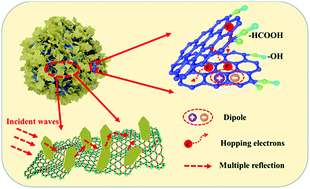Hierarchical CoxAly layered double hydroxide@carbon composites derived from metal–organic frameworks with efficient broadband electromagnetic wave absorption†
Abstract
Porous carbon-based composites have attracted extensive attention because of their good performance. However, designing and synthesizing porous carbon-based composites with excellent electromagnetic wave attenuation capabilities is still a great challenge. Herein, metal–organic frameworks act as good precursors, which can be used to prepare the hierarchical layered double hydroxide@carbon (LDH@C) composites using a facile three-step method. In this work, through the synergetic effects between the layered structure of the double hydroxide (LDH) and porous carbon, the hierarchical LDH@C composites achieved substantially strong electromagnetic wave absorption properties and a broad bandwidth. Furthermore, the hierarchical LDH@C composites with internal void space obtained by adjusting the Co/Al ratio can promote the multiple reflections of electromagnetic waves. As a result, the hierarchical LDH@C composites exhibit highly efficient electromagnetic wave absorption capabilities by adjusting their loading to 20 wt%. Specifically, the maximum reflection loss (RL) of the hierarchical LDH@C composites at 11.36 GHz is −64.8 dB, and the effective absorption bandwidth (RL ≤ −10 dB) of 9.0 GHz can be achieved. The results imply that the microwave absorption properties of the hierarchical LDH@C composites show a broad bandwidth and strong absorption.

- This article is part of the themed collection: Journal of Materials Chemistry C Lunar New Year collection 2021


 Please wait while we load your content...
Please wait while we load your content...